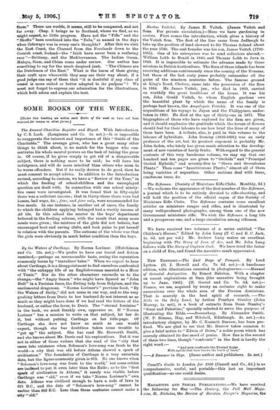Maus Veitehii. By James H. Witch. (James Veitch and Sons.
For private circulation.)—Here we have gardening in excelsis. First comes the introduction, which gives a history of the Veitch firm. The first of the line came from. Jedbergh to take up the position of land steward to Sir Thomas Acland about the year 1790. The real founder was his son, James Veitch (1192- 1855). One of his enterprises was to send collectors abroad,— William Lobb to Brazil in 1840, and Thomas Lobb to Java in 1843. It is impossible to estimate the advance made by these missions in British horticulture. The flora of these islands has been receiving additions continuously since the coming of the Romans, but those of the last sixty years probably outnumber all the gains of the nineteen centuries before. The famous ground at King's Road, Chelsea, came into the possession of the firm in 1854. Mr. James Veitch, jun., who died in 1869, carried on worthily the great traditions of the house. It was his son, John Gould Veitch, to whom English gardens owe the beautiful plant by which the name of the family is perhaps best known, the Ampelopsis Veitchii. It was one of the acquisitions of his voyage to Japan and the Philippines, under- taken in 1860. He died at the age of thirty-one in 1871. The biographies of those who have explored for the firm are given, and it should emphasise the gratitude which the lovers of flowers should feel for their labours to see how brief the lives of many of them have been. A tribute, also, is paid in this volume to the labours of hybridists. John Dominy (1816-1891) was an early professor of the art, but its greatest exponent is probably Mr. John Seden, who lately has given much attention to the develop- ment of new varieties of hardy fruits. With regard to the general contents of this very handsome volume, we may say that one hundred and ten pages are given to "Orchids" and "Principal Orchid Hybrids," and seventy-five to "Stove and Greenhouse Plants." Then come "Insectivorous Plants," almost all of them being varieties of nepenthes. Other sections deal with ferns, coniferous trees, &c.








































 Previous page
Previous page